
Originally appeared here:
Databricks DBRX is now available in Amazon SageMaker JumpStart
Go Here to Read this Fast! Databricks DBRX is now available in Amazon SageMaker JumpStart
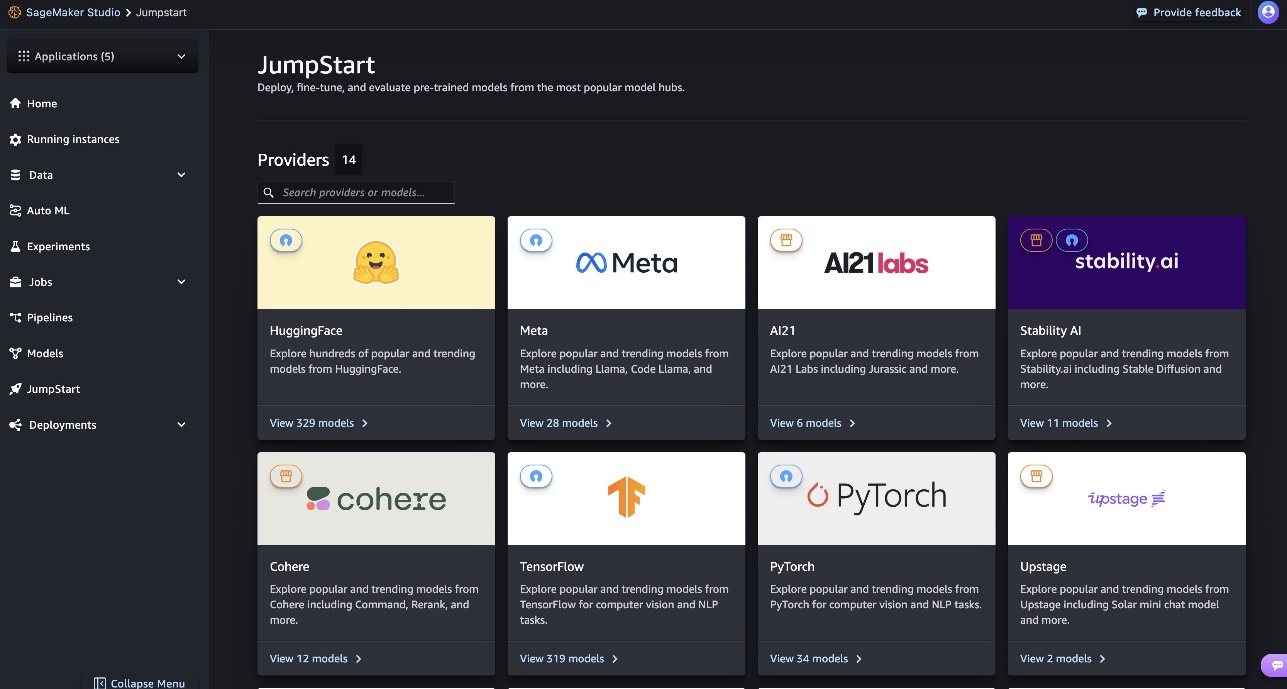

Originally appeared here:
Databricks DBRX is now available in Amazon SageMaker JumpStart
Go Here to Read this Fast! Databricks DBRX is now available in Amazon SageMaker JumpStart
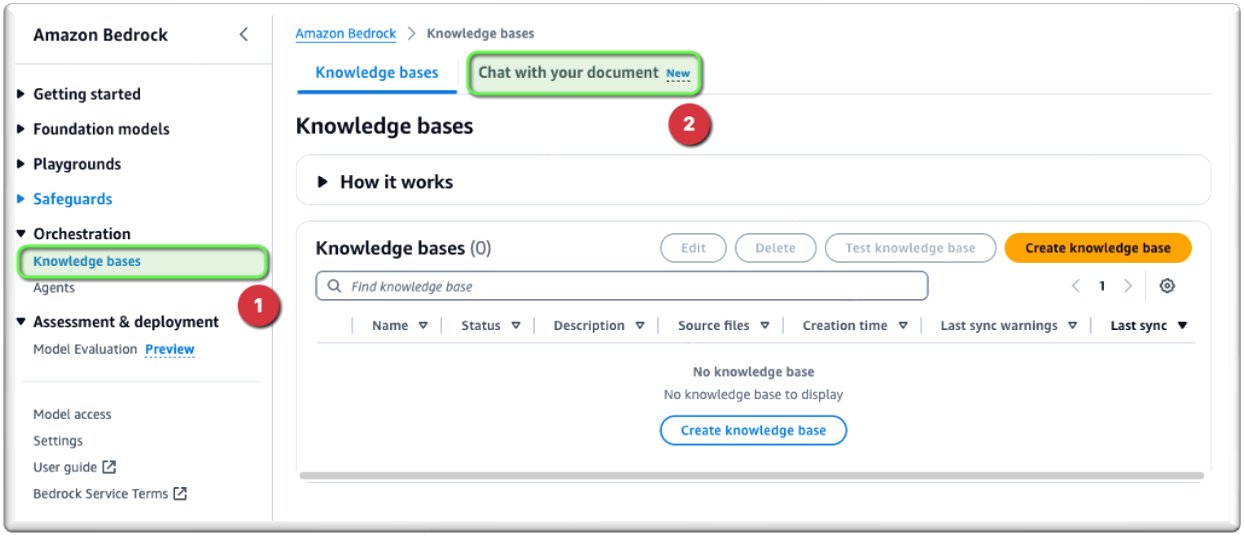

Originally appeared here:
Knowledge Bases in Amazon Bedrock now simplifies asking questions on a single document



Have you faced a crash in your machine learning production environments?
It’s not fun, and especially when it comes to issues that could be avoided. One issue that frequently causes problems is one-hot encoding of data. Drawing from my own experience, I’ve learned that many of these issues can largely be avoided by following a few best practices related to one-hot encoding. In this article I will briefly introduce the topic with a few simple examples and share some best practices to ensure stability of your machine learning models.
One-hot encoding is the practice of turning a factor variable that is stored in a column into dummy variables stored over multiple columns and represented as 0s and 1s. A simple example illustrates the concept.
Consider for example this dataset with some numbers and some columns for colours:
import pandas as pd
# Creating the training_data DataFrame in Python
training_data = pd.DataFrame({
'numerical_1': [1, 2, 3, 4, 5, 6, 7, 8],
'color_1_': ['black', 'black', 'red', 'green',
'green', 'black', 'red', 'blue'],
'color_2_': ['black', 'blue', 'pink', 'purple',
'black', 'blue', 'pink', 'purple']
})
Or more visually:
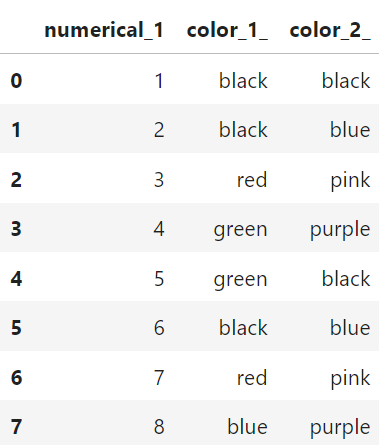
The column color_1_could also be represented like in the table below:
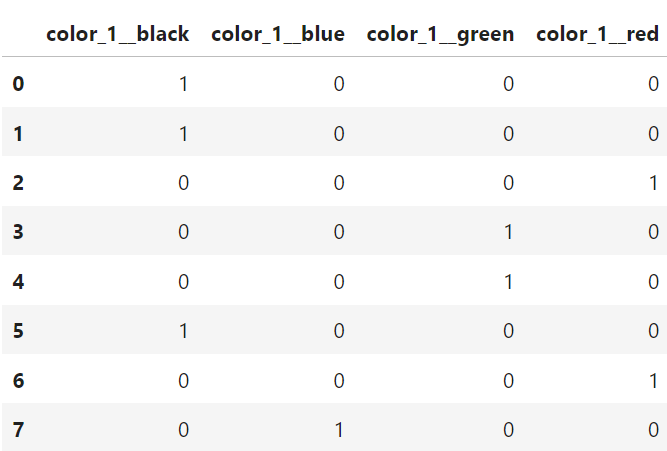
Changing color_1_ from a one-column compact representation of a categorical variable into a multi-column binary representation is what we call one-hot encoding.
There are multiple reasons to use one-hot encoding. They could be related to avoiding implicit ordering, improving model performance, or just making the data compatible with various algorithms.
For example, when you encode a categorical variable like colour, into a numerical structure, (e.g. 1 for black, 2 for green, 3 for red) without converting it to dummy variables, a model could mistakenly misinterpret the data to imply an order ( black < green < red) when no such order exists.
Also, when training neural nets, it is best practice to normalize the data before sending it into the neural net, and with categorical variables, one-hot encoding can be a good method. Other linear models, like logistic and linear regression assume linear relationships and numerical inputs so for this class of models, one-hot encoding can be a good idea as well.
In addition, the process of doing one-hot encoding forces us to ensure we don’t feed unseen factor levels into our machine learning models.
Ultimately, one-hot encoding makes it easier for the machine learning models to interpret the data and thus make better predictions.
The way we build traditional machine learning models is to first train the models on a “training dataset” — typically a dataset of historic values — and then later we generate predictions on a new dataset, the “inference dataset.” If the columns of the training dataset and the inference dataset don’t match, your machine learning algorithm will usually fail. This is primarily due to either missing or new factor levels in the inference dataset.
For the following examples, assume that you used the dataset above to train your machine learning model. You one-hot encoded the dataset into dummy variables, and your fully transformed training data looks like below:

Now, let’s introduce the inference dataset, this is what you would use for making predictions. Let’s say it is given like below:
# Creating the inference_data DataFrame in Python
inference_data = pd.DataFrame({
'numerical_1': [11, 12, 13, 14, 15, 16, 17, 18],
'color_1_': ['black', 'blue', 'black', 'green',
'green', 'black', 'black', 'blue'],
'color_2_': ['orange', 'orange', 'black', 'orange',
'black', 'orange', 'orange', 'orange']
})
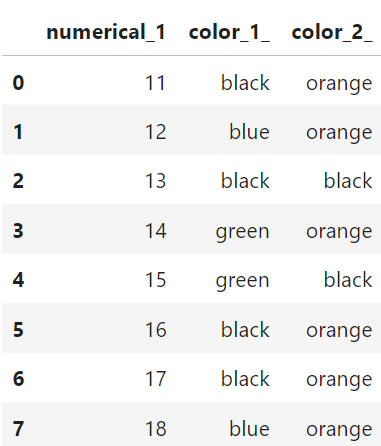
Using a naive one-hot encoding strategy like we used above (pd.get_dummies)
# Converting categorical columns in inference_data to
# Dummy variables with integers
inference_data_dummies = pd.get_dummies(inference_data,
columns=['color_1_', 'color_2_']).astype(int)
This would transform your inference dataset in the same way, and you obtain the dataset below:
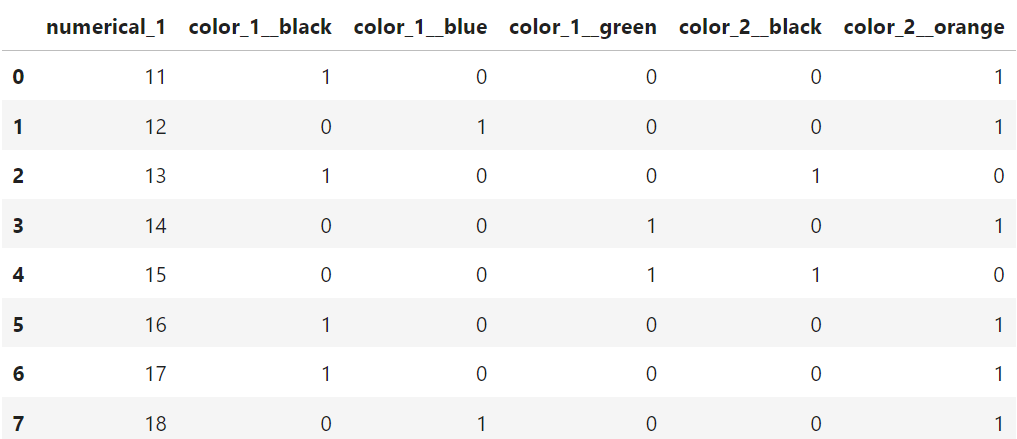
Do you notice the problems? The first problem is that the inference dataset is missing the columns:
missing_colmns =['color_1__red', 'color_2__pink',
'color_2__blue', 'color_2__purple']
If you ran this in a model trained with the “training dataset” it would usually crash.
The other problem that can occur with one-hot encoding is if your inference dataset includes new and unseen factors. Consider again the same datasets as above. If you examine closely, you see that the inference dataset now has a new column: color_2__orange.
This is the opposite problem as previously, and our inference dataset contains new columns which our training dataset didn’t have. This is actually a common occurrence and can happen if one of your factor variables had changes. For example, if the colours above represent colours of a car, and a car producer suddenly started making orange cars, then this data might not be available in the training data, but could nonetheless show up in the inference data. In this case you need a robust way of dealing with the issue.
One could argue, well why don’t you list all the columns in the transformed training dataset as columns that would be needed for your inference dataset? The problem here is that you often don’t know what factor levels are in the training data upfront.
For example, new levels could be introduced regularly, which could make it difficult to maintain. On top of that comes the process of then matching your inference dataset with the training data, so you would need to check all actual transformed column names that went into the training algorithm, and then match them with the transformed inference dataset. If any columns were missing you would need to insert new columns with 0 values and if you had extra columns, like the color_2__orange columns above, those would need to be deleted. This is a rather cumbersome way of solving the issue, and thankfully there are better options available.
The solution to this problem is rather straightforward, however many of the packages and libraries that attempt to streamline the process of creating prediction models fail to implement it well. The key lies in having a function or class that is first fitted on the training data, and then use that same instance of the function or class to transform both the training dataset and the inference dataset. Below we explore how this is done using both Python and R.
Python is arguably one the best programming language to use for machine learning, largely due to its extensive network of developers and mature package libraries, and its ease of use, which promotes rapid development.
Regarding the issues related to one-hot encoding we described above, they can be mitigated by using the widely available and tested scikit-learn library, and more specifically the sklearn.preprocessing.OneHotEncoder class. So, let’s see how we can use that on our training and inference datasets to create a robust one-hot encoding.
from sklearn.preprocessing import OneHotEncoder
# Initialize the encoder
enc = OneHotEncoder(handle_unknown='ignore')
# Define columns to transform
trans_columns = ['color_1_', 'color_2_']
# Fit and transform the data
enc_data = enc.fit_transform(training_data[trans_columns])
# Get feature names
feature_names = enc.get_feature_names_out(trans_columns)
# Convert to DataFrame
enc_df = pd.DataFrame(enc_data.toarray(),
columns=feature_names)
# Concatenate with the numerical data
final_df = pd.concat([training_data[['numerical_1']],
enc_df], axis=1)
This produces a final DataFrameof transformed values as shown below:

If we break down the code above, we see that the first step is to initialize the an instance of the encoder class. We use the option handle_unknown=’ignore’ so that we avoid issues with unknow values for the columns when we use the encoder to transform on our inference dataset.
After that, we combine a fit and transform action into one step with the fit_transform method. And finally, we create a new data frame from the encoded data and concatenate it with the rest of the original dataset.
Now the task remains to use the encoder to transform our inference dataset.
# Transform inference data
inference_encoded = enc.transform(inference_data[trans_columns])
inference_feature_names = enc.get_feature_names_out(trans_columns)
inference_encoded_df = pd.DataFrame(inference_encoded.toarray(),
columns=inference_feature_names)
final_inference_df = pd.concat([inference_data[['numerical_1']],
inference_encoded_df], axis=1)
Unlike earlier, when we used the naive pandas.get_dummies ,we now see that our new final_inference_df dataset has the same columns as our training dataset.

In addition to what we showed in the code above, the OneHotEncoder class from sklearn.preprocessing has a lot of other functionality that can be useful as well.
For example, it allows you set the min_frequency and max_categories options. As its name implies the min_frequency options allow you to specify the minimum frequency below which a category will be considered infrequent and then grouped together with other infrequent categories, or the max_categories option which limits the total number of categories. The latter can be especially useful if you don’t want to create too many columns in your training dataset.
For a full overview of the functionality, visit the documentation pages here:
sklearn.preprocessing.OneHotEncoder
Several of my clients use R for running machine learning models in production — and it has a lot of great features. Before polars came out for Python, R’s data.table package was superior to what pandas could offer in terms of speed and efficiency. However, R doesn’t have access to the same type of production level packages as scikit-learn for python. (There are a few libraries, but they are not as mature as scikit-learn.) In addition, while some packages might have the required functionality, they require loads of other packages to run and can introduce dependency conflicts into your code. Consider running the line below in a docker container build with the r-base image:
RUN R -e "install.packages('recipes', dependencies=TRUE, repos='https://cran.rstudio.com/')"
It takes forever to install and takes up a lot of space on your container image. Our solution in this case — instead of using functions from a pre-built package like recipes — is to introduce our own simple function implemented using the data.table package:
library(data.table)
OneHotEncoder <- function() {
# Local variables
categories <- list()
# Method to fit data and extract categories
fit <- function(dt, columns) {
for (column in columns) {
categories[[column]] <<- unique(dt[[column]])
}
}
# Method to turn columns into factors and
factorize <- function(dt) {
for (column_name in names(categories)) {
set(dt, j = column_name,
value = factor(dt[[column_name]],
levels = categories[[column_name]]))
}
return(dt)
}
# Method to transform columns in categories list to
# dummy variables
transform <- function(dt) {
dt = factorize(dt)
# add row number for joins later
dt[, rn := .I]
for (col in names(categories)) {
print(col)
# Construct the formula dynamically
formula_str <- paste("~", col, "- 1")
formula_obj <- as.formula(formula_str)
# Create a model model.matrix object
mm = model.matrix(formula_obj, dt)
mm_dt <- as.data.table(mm, keep.rownames = "rn")
mm_dt[, rn := as.integer(rn)]
# Perform a merge based on these row numbers
dt <- merge(dt, mm_dt, by = "rn", all = TRUE)
# remove the original column
dt[, (col) := NULL]
# set any new NAs to 0
for (ncol in names(mm_dt)) {
set(dt, which(is.na(dt[[ncol]])), ncol, 0)
}
}
dt[, rn := NULL]
return(dt)
}
# Method to get categories
get_categories <- function() {
return(categories)
}
# Return a list of methods
list(
get_categories = get_categories,
fit = fit,
transform = transform
)
}
Let’s go through this function and see how it works on our training and inference datasets. (R is slightly different from Python and instead of using a class, we use a parent function instead, which works in a similar way.)
First, we need to create an instance of the function:
encoder = OneHotEncoder()
Then, just like with the OneHotEncoder class from sklearn.preprocessing, we also have a fit function inside our OneHotEncoder. We use the fit function on the training data, supplying both the training dataset and the columns we want to one-hot encode.
# Columns to one-hot encode
fit_columns = c("color_1_", "color_2")
# Use the fit method
encoder$fit(dt=training_data, columns=fit_columns)
The fit function simply loops through all the columns we want to use to for training and finds all the unique values each of the columns contain. This list of columns and their potential values is then used in the transform function. We now have a instance of a fitted one-hot encoder function and we can save it for later use using a R .RDS file.
saveRDS(encoder, "~/my_encoder.RDS")
To generate the one-hot encoded dataset we need for training, we run the transform function on the training data:
transformed_training_data = encoder$transform(training_data)
The transform function is a little bit more complicated than the fit function, and the first thing it does is to convert the supplied columns into factors — using the original unique values of the columns as factor levels. Then, we loop through each of the predictor columns and create model.matrix objects of the data. These are then added back to the original dataset and the original factor column is removed. We also make sure to set any of the missing values to 0.
We now get the exact same dataset as before:

And finally, when we need to one-hot encode our inference dataset, we then run the same instance of the encoder function on that dataset:
transformed_inference_data = encoder$transform(inference_data)
This process ensures we have the same columns in our transformed_inference_data as we do in our transformed_training_data.
Before we conclude there are a few extra considerations to mention. As with many other things in machine learning there isn’t always an easy answer as to when and how to use a specific technique. Even though it clearly mitigates some issues, new problems can also arise when doing one-hot encoding. Most commonly, these are related to how to deal with high cardinality categorical variables and how to deal with memory issues because of increasing the table size.
In addition, there are alternative coding techniques such as label encoding, embeddings, or target encodings which sometimes could be preferable to one-hot encoding.
Each of these topics is rich enough to warrant a dedicated article, so we will leave those for the interested reader to explore further.
We have shown how naive use of one-hot encoding techniques can lead to mistakes and problems with inference data, and we have also seen how to mitigate and resolve those issues using both Python and R. If left unresolved, poor management of one-hot encoding can potentially lead to crashes and problems with your inference, so it is strongly recommended to use more robust techniques—like either sklearn’s OneHotEncoder or the R function we developed.
Thanks for reading!
All the code presented and used in the article can be found in the following Github repo: https://github.com/hcekne/robust_one_hot_encoding
If you enjoyed reading this article and would like to access more content from me please feel free to connect with me on LinkedIn at https://www.linkedin.com/in/hans-christian-ekne-1760a259/ or visit my webpage at https://www.ekneconsulting.com/ to explore some of the services I offer. Don’t hesitate to reach out via email at [email protected]
Robust One-Hot Encoding was originally published in Towards Data Science on Medium, where people are continuing the conversation by highlighting and responding to this story.
Originally appeared here:
Robust One-Hot Encoding



If you’ve spent any time with APIs for LLMs like those from OpenAI or Anthropic, you’ll have seen the temperature setting available in the API. How is this parameter used, and how does it work?
From the Anthropic chat API documentation:
temperature (number)
Amount of randomness injected into the response.
Defaults to 1.0. Ranges from 0.0 to 1.0. Use temperature closer to 0.0 for
analytical / multiple choice, and closer to 1.0 for creative and
generative tasks.
Note that even with temperature of 0.0, the results will not be
fully deterministic.
Temperature (as is generally implemented) doesn’t really inject randomness into the response. In this post, I’ll walk through what this setting does, and how it’s used in beam search, the most common text generation technique for LLMs, as well as demonstrate some output-generation examples (failures and successes) using a reference implementation in Github.
What you’re getting yourself into:
If you’re here, you probably have some understanding of how LLMs work.
At a high level, LLM text generation involves predicting the next token in a sequence, which depends on the cumulative probability of the preceding tokens. This process utilizes internal probability distributions that are shaped by:
Transformer-based generative models build representations of their input contexts through Self-Attention, allowing them to dynamically assess and prioritize different parts of the input based on their relevance to the current prediction point. During sequence decoding, these models evaluate how each part of the input influences the emerging sequence, ensuring that each new token reflects an integration of both the input and the evolving output (largely through Cross-Attention).
The Stanford CS224N course materials are a great resource for these concepts.
The key point I want to make here is that when the model decides on the probabilistically best token, it’s generally evaluating the entire input context, as well as the entire generated sequence in-progress. However, the most intuitive process for using these predictions to iteratively build text sequences is simplistic: a greedy algorithm, where the output text is built based on the most-likely token at every step.
Below I’ll discuss how it works, where it fails, and some techniques used to adapt to those failures.
The most natural way to use a model to build an output sequence is to gradually predict the next-best token, append it to a generated sequence, and continue until the end of generation. This is called greedy search, and is the most simple and efficient way to generate text from an LLM (or other model). In its most basic form, it looks something like this:
sequence = ["<start>"]
while sequence[-1] != "<end>":
# Given the input context, and seq so far, append most likely next token
sequence += model(input, sequence)
return "".join(sequence)
Undergrad Computer Science algorithms classes have a section on graph traversal algorithms. If you model the universe of potential LLM output sequences as a graph of tokens, then the problem of finding the optimal output sequence, given input context, closely resembles the problem of traversing a weighted graph. In this case, the edge “weights” are probabilities generated from attention scores, and the goal of the traversal is to minimize the overall cost (maximize the overall probability) from beginning to end.

Out of all possible text generation methods, this is the most computationally efficient — the number of inferences is 1:1 with the number of output tokens. However, there are some problems.
At every step of token generation, the algorithm selects the highest-probability token given the output sequence so far, and appends it to that sequence. This is the simplicity and flaw of this approach, along with all other greedy algorithms — it gets trapped in local minima. Meaning, what appears to be the next-best token right now may not, in fact, be the next-best token for the generated output overall.
"We can treat it as a matter of"
[course (p=0.9) | principle (p=0.5)] | cause (p=0.2)]"
Given some input context and the generated string so far, We can treat it as a matter of course seems like a logical and probable sequence to generate.
But what if the contextually-accurate sentence is We can treat it as a matter of cause and effect? Greedy search has no way to backtrack and rewrite the sequence token course with cause and effect. What seemed like the best token at the time actually trapped output generation into a suboptimal sequence.
The need to account for lower-probability tokens at each step, in the hope that better output sequences are generated later, is where beam search is useful.
Returning to the graph-search analogy, in order to generate the optimal text for any given query and context, we’d have to fully explore the universe of potential token sequences. The solution resembles the A* search algorithm (more closely than Dijkstra’s algorithm, since we don’t necessarily want shortest path, but lowest-cost/highest-likelihood).

Since we’re working with natural language, the complexity involved is far too high to exhaust the search space for every query in most contexts. The solution is to trim that search space down to a reasonable number of candidate paths through the candidate token graph; maybe just 4, 8, or 12.
Beam search is the heuristic generally used to approximate that ideal A*-like outcome. This technique maintains k candidate sequences which are incrementally built up with the respective top-k most likely tokens. Each of these tokens contributes to an overall sequence score, and after each step, the total set of candidate sequences are pruned down to the best-scoring top k.

The “beam” in beam search borrows the analogy of a flashlight, whose beam can be widened or narrowed. Taking the example of generating the quick brown fox jumps over the lazy dog with a beam width of 2, the process looks something like this:

At this step, two candidate sequences are being maintained: “the” and “a”. Each of these two sequences need to evaluate the top-two most likely tokens to follow.
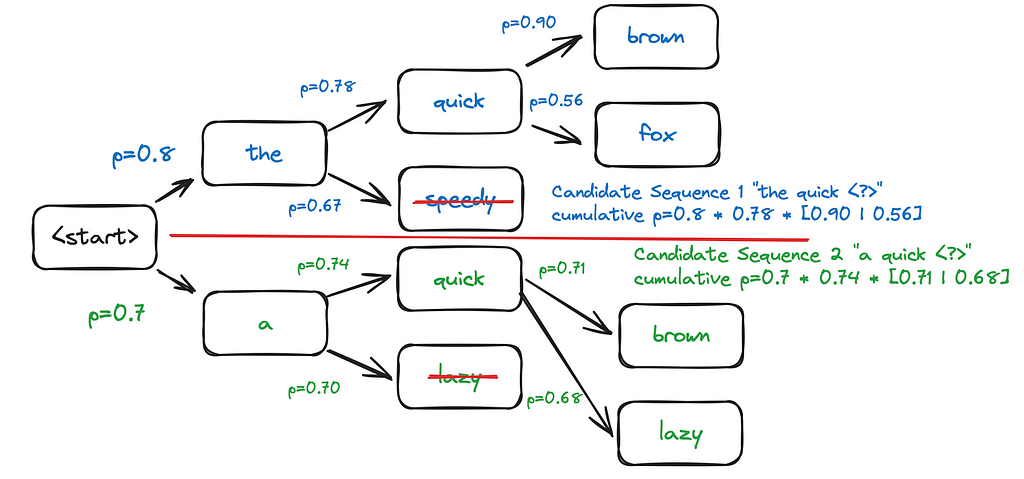
After the next step, “the speedy” has been eliminated, and “the quick” has been selected as the first candidate sequence. For the second, “a lazy” has been eliminated, and “a quick” has been selected, as it has a higher cumulative probability. Note that if both candidates above the line have a higher likelihood that both candidates below the line, then they will represent the two candidate sequences after the subsequent step.
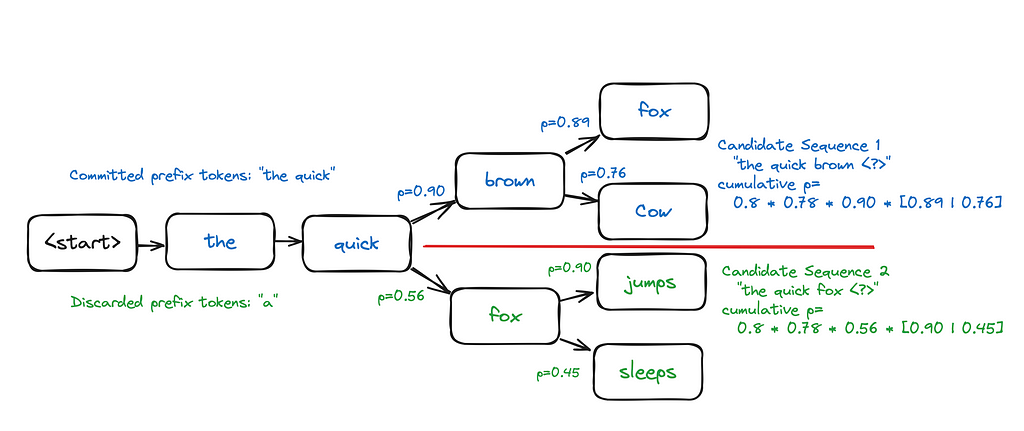
This process continues until either a maximum token length limit has been reached, or all candidate sequences have appended an end-of-sequence token, meaning we’ve concluded generating text for that sequence.
Increasing the beam width increases the search space, increasing the likelihood of a better output, but at a corresponding increase space and computational cost. Also note that a beam search with beam_width=1 is effectively identical to greedy search.
Now, what does temperature have to do with all of this? As I mentioned above, this parameter doesn’t really inject randomness into the generated text sequence, but it does modify the predictability of the output sequences. Borrowing from information theory: temperature can increase or decrease the entropy associated with a token prediction.
The softmax activation function is typically used to convert the raw outputs (ie, logits) of a model’s (including LLMs) prediction into a probability distribution (I walked through this a little here). This function is defined as follows, given a vector Z with n elements:

This function emits a vector (or tensor) of probabilities, which sum to 1.0 and can be used to clearly assess the model’s confidence in a class prediction in a human-interpretable way.
A “temperature” scaling parameter T can be introduced which scales the logit values prior to the application of softmax.

The application of T > 1.0 has the effect of scaling down logit values and produces the effect of the muting the largest differences between the probabilities of the various classes (it increases entropy within the model’s predictions)
Using a temperature of T < 1.0 has the opposite effect; it magnifies the differences, meaning the most confident predictions will stand out even more compared to alternatives. This reduces the entropy within the model’s predictions.
In code, it looks like this:
scaled_logits = logits_tensor / temperature
probs = torch.softmax(scaled_logits, dim=-1)
Take a look at the effect over 8 possible classes, given some hand-written logit values:

The above graph was plotted using the following values:
ts = [0.5, 1.0, 2.0, 4.0, 8.0]
logits = torch.tensor([3.123, 5.0, 3.234, 2.642, 2.466, 3.3532, 3.8, 2.911])
probs = [torch.softmax(logits / t, dim=-1) for t in ts]
The bars represent the logit values (outputs from model prediction), and the lines represent the probability distribution over those classes, with probabilities defined on the right-side label. The thick red line represents the expected distribution, with temperature T=1.0, while the other lines demonstrate the change in relative likelihood with a temperature range from 0.5 to 8.0.
You can clearly see how T=0.5 emphasizes the likelihood of the largest-magnitude logit index, while T=8.0 reduces the difference in probabilities between classes to almost nothing.
>>> [print(f' t={t}n l={(logits/t)}n p={p}n') for p,t in zip(probs, ts)]
t=0.5
l=tensor([6.2460, 10.000, 6.4680, 5.2840, 4.9320, 6.7064, 7.6000, 5.8220])
p=tensor([0.0193, 0.8257, 0.0241, 0.0074, 0.0052, 0.0307, 0.0749, 0.0127])
t=1.0
l=tensor([3.1230, 5.0000, 3.2340, 2.6420, 2.4660, 3.3532, 3.8000, 2.9110])
p=tensor([0.0723, 0.4727, 0.0808, 0.0447, 0.0375, 0.0911, 0.1424, 0.0585])
t=2.0
l=tensor([1.5615, 2.5000, 1.6170, 1.3210, 1.2330, 1.6766, 1.9000, 1.4555])
p=tensor([0.1048, 0.2678, 0.1108, 0.0824, 0.0754, 0.1176, 0.1470, 0.0942])
t=4.0
l=tensor([0.7807, 1.2500, 0.8085, 0.6605, 0.6165, 0.8383, 0.9500, 0.7278])
p=tensor([0.1169, 0.1869, 0.1202, 0.1037, 0.0992, 0.1238, 0.1385, 0.1109])
t=8.0
l=tensor([0.3904, 0.6250, 0.4042, 0.3302, 0.3083, 0.4191, 0.4750, 0.3639])
p=tensor([0.1215, 0.1536, 0.1232, 0.1144, 0.1119, 0.1250, 0.1322, 0.1183])
Now, this doesn’t necessarily change the relative likelihood between any two classes (numerical stability issues aside), so how does this have any practical effect in sequence generation?
The answer lies back in the mechanics of beam search. A temperature value greater than 1.0 makes it less likely a high-scoring individual token will outweigh a series of slightly-less-likely tokens, which in conjunction result in a better-scoring output.
>>> sum([0.9, 0.3, 0.3, 0.3]) # raw probabilities
1.8 # dominated by first token
>>> sum([0.8, 0.4, 0.4, 0.4]) # temperature-scaled probabilities
2.0 # more likely overall outcome
Beam search implementations typically work with log-probabilities of the softmax probabilities, which is common in the ML domain among many others. The reasons include:
This also means that the values of the log probs we’re using as scores are negative real numbers. Since softmax produces a probability distribution which sums to 1.0, the logarithm of any class probability is thus ≤ 1.0 which results in a negative value. This is slightly annoying, however it is consistent with the property that higher-valued scores are better, while greatly negative scores reflect extremely unlikely outcomes:
>>> math.log(3)
1.0986122886681098
>>> math.log(0.99)
-0.01005033585350145
>>> math.log(0.98)
-0.020202707317519466
>>> math.log(0.0001)
-9.210340371976182
>>> math.log(0.000000000000000001)
-41.44653167389282
Here’s most of the example code, highly annotated, also available on Github. Definitions for GeneratedSequence and ScoredToken can be found here; these are mostly simple wrappers for tokens and scores.
# The initial candidate sequence is simply the start token ID with
# a sequence score of 0
candidate_sequences = [
GeneratedSequence(tokenizer, start_token_id, end_token_id, 0.0)
]
for i in tqdm.tqdm(range(max_length)):
# Temporary list to store candidates for the next generation step
next_step_candidates = []
# Iterate through all candidate sequences; for each, generate the next
# most likely tokens and add them to the next-step sequnce of candidates
for candidate in candidate_sequences:
# skip candidate sequences which have included the end-of-sequence token
if not candidate.has_ended():
# Build a tensor out of the candidate IDs; add a single batch dimension
gen_seq = torch.tensor(candidate.ids(), device=device).unsqueeze(0)
# Predict next token
output = model(input_ids=src_input_ids, decoder_input_ids=gen_seq)
# Extract logits from output
logits = output.logits[:, -1, :]
# Scale logits using temperature value
scaled_logits = logits / temperature
# Construct probability distribution against scaled
# logits through softmax activation function
probs = torch.softmax(scaled_logits, dim=-1)
# Select top k (beam_width) probabilities and IDs from the distribution
top_probs, top_ids = probs.topk(beam_width)
# For each of the top-k generated tokens, append to this
# candidate sequence, update its score, and append to the list of next
# step candidates
for i in range(beam_width):
# the new token ID
next_token_id = top_ids[:, i].item()
# log-prob of the above token
next_score = torch.log(top_probs[:, i]).item()
new_seq = deepcopy(candidate)
# Adds the new token to the end of this sequence, and updates its
# raw and normalized scores. Scores are normalized by sequence token
# length, to avoid penalizing longer sequences
new_seq.append(ScoredToken(next_token_id, next_score))
# Append the updated sequence to the next candidate sequence set
next_step_candidates.append(new_seq)
else:
# Append the canddiate sequence as-is to the next-step candidates
# if it already contains an end-of-sequence token
next_step_candidates.append(candidate)
# Sort the next-step candidates by their score, select the top-k
# (beam_width) scoring sequences and make them the new
# candidate_sequences list
next_step_candidates.sort()
candidate_sequences = list(reversed(next_step_candidates))[:beam_width]
# Break if all sequences in the heap end with the eos_token_id
if all(seq.has_ended() for seq in candidate_sequences):
break
return candidate_sequences
In the next section, you can find some results of running this code on a few different datasets with different parameters.
As I mentioned, I’ve published some example code to Github, which uses the t5-small transformer model from Hugging Face and its corresponding T5Tokenizer. The examples below were run through the T5 model against the quick brown fox etc Wikipedia page, sanitized through an extractor script.
Running –greedy mode:
$ python3 src/main.py --greedy --input ./wiki-fox.txt --prompt "summarize the following document"
greedy search generation results:
[
the phrase is used in the annual Zaner-Bloser National Handwriting Competition.
it is used for typing typewriters and keyboards, typing fonts. the phrase
is used in the earliest known use of the phrase.
]
This output summarizes part of the article well, but overall is not great. It’s missing initial context, repeats itself, and doesn’t state what the phrase actually is.
Let’s try again, this time using beam search for output generation, using an initial beam width of 4 and the default temperature of 1.0
$ python3 src/main.py --beam 4 --input ./wiki-fox.txt --prompt "summarize the following document"
[lots of omitted output]
beam search (k=4, t=1.0) generation results:
[
"the quick brown fox jumps over the lazy dog" is an English-language pangram.
the phrase is commonly used for touch-typing practice, typing typewriters and
keyboards. it is used in the annual Zaner-Bloser National
Handwriting Competition.
]
This output is far superior to the greedy output above, and the most remarkable thing is that we’re using the same model, prompt and input context to generate it.
There are still a couple mistakes in it; for example “typing typewriters”, and perhaps “keyboards” is ambiguous.
The beam search code I shared will emit its decision-making progress as it progresses through the text generation (full output here). For example, the first two steps:
beginning beam search | k = 4 bos = 0 eos = 1 temp = 1.0 beam_width = 4
0.0: [], next token probabilities:
p: 0.30537632: ▁the
p: 0.21197866: ▁"
p: 0.13339639: ▁phrase
p: 0.13240208: ▁
next step candidates:
-1.18621039: [the]
-1.55126965: ["]
-2.01443028: [phrase]
-2.02191186: []
-1.1862103939056396: [the], next token probabilities:
p: 0.61397356: ▁phrase
p: 0.08461960: ▁
p: 0.06939770: ▁"
p: 0.04978605: ▁term
-1.5512696504592896: ["], next token probabilities:
p: 0.71881396: the
p: 0.08922042: qui
p: 0.05990228: The
p: 0.03147057: a
-2.014430284500122: [phrase], next token probabilities:
p: 0.27810165: ▁used
p: 0.26313403: ▁is
p: 0.10535818: ▁was
p: 0.03361856: ▁
-2.021911859512329: [], next token probabilities:
p: 0.72647911: earliest
p: 0.19509122: a
p: 0.02678721: '
p: 0.00308457: s
next step candidates:
-1.67401379: [the phrase]
-1.88142237: ["the]
-2.34145740: [earliest]
-3.29419887: [phrase used]
-3.34952199: [phrase is]
-3.65579963: [the]
-3.65619993: [a]
Now if we look at the set of candidates in the last step:
next step candidates:
-15.39409454: ["the quick brown fox jumps over the lazy dog" is an English-language pangram. the phrase is commonly used for touch-typing practice, typing typewriters and keyboards. it is used in the annual Zaner-Bloser National Handwriting Competition.]
-16.06867695: ["the quick brown fox jumps over the lazy dog" is an English-language pangram. the phrase is commonly used for touch-typing practice, testing typewriters and keyboards. it is used in the annual Zaner-Bloser National Handwriting Competition.]
-16.10376084: ["the quick brown fox jumps over the lazy dog" is an English-language pangram. the phrase is commonly used for touch-typing practice, typing typewriters and keyboards. it is used in the annual Zaner-Bloser national handwriting competition.]
You can see that the top-scoring sentence containing typing typewriters outscored the sentence containing testing typewriters by -15.39 to -16.06, which, if we raise to Euler’s constant to convert back into cumulative probabilities, is a probabilistic difference of just 0.00001011316%. There must be a way to overcome this tiny difference!
Let’s see if this summarization could be improved by applying a temperature value to smooth over some of the log probability scores. Again, everything else, the model, and the input context, will otherwise be identical to the examples above.
$ python3 src/main.py --beam 4 --temperature 4.0 --input ./wiki-fox.txt --prompt "summarize the following document"
[lots of omitted output]
beam search (k=4, t=4.0) generation results:
[
"the quick brown fox jumps over the lazy dog" is an English-language pangram.
it is commonly used for touch-typing practice, testing typewriters and
computer keyboards. earliest known use of the phrase started with "A"
]
This output correctly emitted “testing typewriters” rather than “typing typewriters” and specified “computer keyboards”. It also, interestingly, chose the historical fact that this phrase originally started with “a quick brown fox” over the Zaner-Bloser competition fact above. The full output is also available here.
Whether or not this output is better is a subjective matter of opinion. It’s different in a few nuanced ways, and the usage and setting of temperature values will vary by application. I think its better, and again, its interesting because no model weights, model architecture, or prompt was changed to obtain this output.
Let’s see if the beam search, with temperature settings used above, works properly for my favorite English-language linguistic construct: Buffalo buffalo Buffalo buffalo buffalo buffalo Buffalo buffalo.
$ python3 src/main.py --beam 4 --temperature 4.0 --input ./wiki-buffalo.txt --prompt "summarize the linguistic construct in the following text"
[lots of omitted outputs]
beam search (k=4, t=4.0) generation results:
[
"Buffalo buffalo buffalo buffalo buffalo buffalo buffalo buffalo buffalo
buffalo buffalo buffalo buffalo buffalo buffalo buffalo buffalo buffalo
buffalo buffalo buffalo buffalo buffalo buffalo buffalo buffalo buffalo
buffalo buffalo buffalo buffalo buffalo buffalo buffalo buffalo buffalo
buffalo buffalo buffalo buffalo buffalo buffalo buffalo buffalo buffalo
buffalo buffalo buffalo buffalo buffalo buffalo buffalo buffalo buffalo
buffalo buffalo buffalo buffalo buffalo buffalo
]
Utter disaster, though a predictable one. Given the complexity of this input document, we need additional techniques to handle contexts like this. Interestingly, the final iteration candidates didn’t include a single rational sequence:
next step candidates:
-361.66266489: ["Buffalo buffalo buffalo buffalo buffalo buffalo buffalo buffalo buffalo buffalo buffalo buffalo buffalo buffalo buffalo buffalo buffalo buffalo buffalo buffalo buffalo buffalo buffalo buffalo buffalo buffalo buffalo buffalo buffalo buffalo buffalo buffalo buffalo buffalo buffalo buffalo buffalo buffalo buffalo buffalo buffalo buffalo buffalo buffalo buffalo buffalo buffalo buffalo buffalo buffalo buffalo buffalo buffalo buffalo buffalo buffalo buffalo buffalo buffalo buffalo]
-362.13168168: ["buffalo buffalo buffalo buffalo buffalo buffalo buffalo buffalo buffalo buffalo buffalo buffalo buffalo buffalo buffalo buffalo buffalo buffalo buffalo buffalo buffalo buffalo buffalo buffalo buffalo buffalo buffalo buffalo buffalo buffalo buffalo buffalo buffalo buffalo buffalo buffalo buffalo buffalo buffalo buffalo buffalo buffalo buffalo buffalo buffalo buffalo buffalo buffalo buffalo buffalo buffalo buffalo buffalo buffalo buffalo buffalo buffalo buffalo buffalo buffalo]
-362.22955942: ["Buffalo buffalo buffalo buffalo buffalo buffalo buffalo buffalo buffalo buffalo buffalo buffalo buffalo buffalo buffalo buffalo buffalo buffalo buffalo buffalo buffalo buffalo buffalo buffalo buffalo buffalo buffalo buffalo buffalo buffalo buffalo buffalo buffalo buffalo buffalo buffalo buffalo buffalo buffalo buffalo buffalo buffalo buffalo buffalo buffalo buffalo buffalo buffalo buffalo buffalo buffalo buffalo buffalo buffalo buffalo buffalo buffalo buffalo.]
-362.60354519: ["Buffalo buffalo buffalo buffalo buffalo buffalo buffalo buffalo buffalo buffalo buffalo buffalo buffalo buffalo buffalo buffalo buffalo buffalo buffalo buffalo buffalo buffalo buffalo buffalo buffalo buffalo buffalo buffalo buffalo buffalo buffalo buffalo buffalo buffalo buffalo buffalo buffalo buffalo buffalo buffalo buffalo buffalo buffalo buffalo buffalo buffalo buffalo buffalo buffalo buffalo buffalo buffalo buffalo buffalo buffalo buffalo buffalo buffalo buffalo]
-363.03604889: ["Buffalo buffalo buffalo buffalo buffalo buffalo buffalo buffalo buffalo buffalo buffalo buffalo buffalo buffalo buffalo buffalo buffalo buffalo buffalo buffalo buffalo buffalo buffalo buffalo buffalo buffalo buffalo buffalo buffalo buffalo buffalo buffalo buffalo buffalo buffalo buffalo buffalo buffalo buffalo buffalo buffalo buffalo buffalo buffalo buffalo buffalo buffalo buffalo buffalo buffalo buffalo buffalo buffalo buffalo buffalo buffalo buffalo buffalo buffalo,]
-363.07167459: ["buffalo buffalo buffalo buffalo buffalo buffalo buffalo buffalo buffalo buffalo buffalo buffalo buffalo buffalo buffalo buffalo buffalo buffalo buffalo buffalo buffalo buffalo buffalo buffalo buffalo buffalo buffalo buffalo buffalo buffalo buffalo buffalo buffalo buffalo buffalo buffalo buffalo buffalo buffalo buffalo buffalo buffalo buffalo buffalo buffalo buffalo buffalo buffalo buffalo buffalo buffalo buffalo buffalo buffalo buffalo buffalo buffalo buffalo buffalo]
-363.14155817: ["Buffalo buffalo buffalo buffalo buffalo buffalo buffalo buffalo buffalo buffalo buffalo buffalo buffalo buffalo buffalo buffalo buffalo buffalo buffalo buffalo buffalo buffalo buffalo buffalo buffalo buffalo buffalo buffalo buffalo buffalo buffalo buffalo buffalo buffalo buffalo buffalo buffalo buffalo buffalo buffalo buffalo buffalo buffalo buffalo buffalo buffalo buffalo buffalo buffalo buffalo buffalo buffalo buffalo buffalo buffalo buffalo buffalo buffalo buffalo Buffalo]
-363.28574753: ["Buffalo buffalo buffalo buffalo buffalo buffalo buffalo buffalo buffalo buffalo buffalo buffalo buffalo buffalo buffalo buffalo buffalo buffalo buffalo buffalo buffalo buffalo buffalo buffalo buffalo buffalo buffalo buffalo buffalo buffalo buffalo buffalo buffalo buffalo buffalo buffalo buffalo buffalo buffalo buffalo buffalo buffalo buffalo buffalo buffalo buffalo buffalo buffalo buffalo buffalo buffalo buffalo buffalo buffalo buffalo buffalo buffalo. the]
-363.35553551: ["Buffalo buffalo buffalo buffalo buffalo buffalo buffalo buffalo buffalo buffalo buffalo buffalo buffalo buffalo buffalo buffalo buffalo buffalo buffalo buffalo buffalo buffalo buffalo buffalo buffalo buffalo buffalo buffalo buffalo buffalo buffalo buffalo buffalo buffalo buffalo buffalo buffalo buffalo buffalo buffalo buffalo buffalo buffalo buffalo buffalo buffalo buffalo buffalo buffalo buffalo buffalo buffalo buffalo buffalo buffalo buffalo buffalo buffalo a]
[more of the same]
We can apply a token-specific score decay (more like a penalty) to repeated tokens, which makes them appear less attractive (or more accurately, less likely solutions) to the beam search algorithm:
token_counts = Counter(t.token_id for t in candidate)
# For each of the top-k generated tokens, append to this candidate sequence,
# update its score, and append to the list of next step candidates
for i in range(beam_width):
next_token_id = top_ids[:, i].item() # the new token ID
next_score = torch.log(top_probs[:, i]).item() # log-prob of the above token
# Optionally apply a token-specific score decay to repeated tokens
if decay_repeated and next_token_id in token_counts:
count = token_counts[next_token_id]
decay = 1 + math.log(count + 1)
next_score *= decay # inflate the score of the next sequence accordingly
new_seq = deepcopy(candidate)
new_seq.append(ScoredToken(next_token_id, next_score))
Which results in the following, more reasonable output:
$ python3 src/main.py --decay --beam 4 --temperature 4.0 --input ./wiki-buffalo.txt --prompt "summarize the linguistic construct in the following text"
[lots of omitted outputs]
beam search (k=4, t=4.0) generation results:
[
"Buffalo buffalo" is grammatically correct sentence in English, often
presented as an example of how homophonies can be used to create complicated
language constructs through unpunctuated terms and sentences. it uses three
distinct meanings:An attributive noun (acting
]
You can see where where the scoring penalty pulled the infinite buffalos sequence below the sequence resulting in the above output:
next step candidates:
-36.85023594: ["Buffalo buffalo Buffalo]
-37.23766947: ["Buffalo buffalo"]
-37.31325269: ["buffalo buffalo Buffalo]
-37.45994210: ["buffalo buffalo"]
-37.61866760: ["Buffalo buffalo,"]
-37.73602080: ["buffalo" is]
[omitted]
-36.85023593902588: ["Buffalo buffalo Buffalo], next token probabilities:
p: 0.00728357: ▁buffalo
p: 0.00166316: ▁Buffalo
p: 0.00089072: "
p: 0.00066582: ,"
['▁buffalo'] count: 1 decay: 1.6931471805599454, score: -4.922133922576904, next: -8.33389717334955
['▁Buffalo'] count: 1 decay: 1.6931471805599454, score: -6.399034023284912, next: -10.834506414832013
-37.237669467926025: ["Buffalo buffalo"], next token probabilities:
p: 0.00167652: ▁is
p: 0.00076465: ▁was
p: 0.00072227: ▁
p: 0.00064367: ▁used
-37.313252687454224: ["buffalo buffalo Buffalo], next token probabilities:
p: 0.00740433: ▁buffalo
p: 0.00160758: ▁Buffalo
p: 0.00091487: "
p: 0.00066765: ,"
['▁buffalo'] count: 1 decay: 1.6931471805599454, score: -4.905689716339111, next: -8.306054711921485
['▁Buffalo'] count: 1 decay: 1.6931471805599454, score: -6.433023929595947, next: -10.892056328870039
-37.45994210243225: ["buffalo buffalo"], next token probabilities:
p: 0.00168198: ▁is
p: 0.00077098: ▁was
p: 0.00072504: ▁
p: 0.00065945: ▁used
next step candidates:
-43.62870741: ["Buffalo buffalo" is]
-43.84772754: ["buffalo buffalo" is]
-43.87371445: ["Buffalo buffalo Buffalo"]
-44.16472149: ["Buffalo buffalo Buffalo,"]
-44.30998302: ["buffalo buffalo Buffalo"]
So it turns out we need additional hacks (techniques) like this, to handle special kinds of edge cases.
This turned out to be much longer than what I was planning to write; I hope you have a few takeaways. Aside from simply understanding how beam search and temperature work, I think the most interesting illustration above is how, even given the incredible complexity and capabilities of LLMs, implementation choices affecting how their predictions are used have a huge effect on the quality on their output. The application of simple undergraduate Computer Science concepts to sequence construction can result in dramatically different LLM outputs, even with all other input being identical.
When we encounter hallucinations, errors, or other quirks when working with LLMs, its entirely possible (and perhaps likely) that these are quirks with the output sequence construction algorithms, rather than any “fault” of the trained model itself. To the user of an API, it’s almost impossible to tell the difference.
I think this is an interesting example of the complexity of the machinery around LLMs which make them such powerful tools and products today.
Temperature Scaling and Beam Search Text Generation in LLMs, for the ML-Adjacent was originally published in Towards Data Science on Medium, where people are continuing the conversation by highlighting and responding to this story.
Originally appeared here:
Temperature Scaling and Beam Search Text Generation in LLMs, for the ML-Adjacent


Learn how to download a clipped Sentinel-2 image for any Area of Interest (AOI), Lake Tahoe here, with just 12 lines of script.
Originally appeared here:
A Simple Way for Downloading Hundreds of Clipped Satellite Images Without Retrieving the Entire…
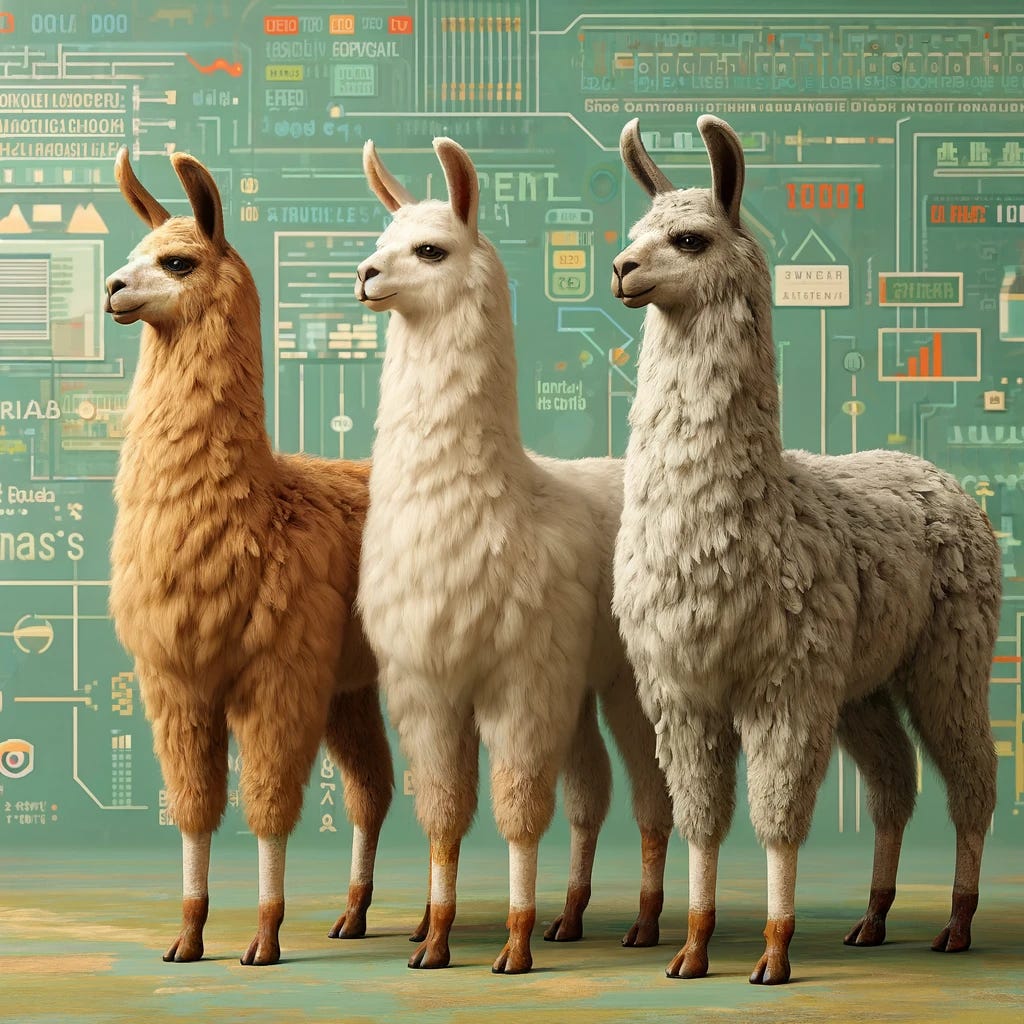
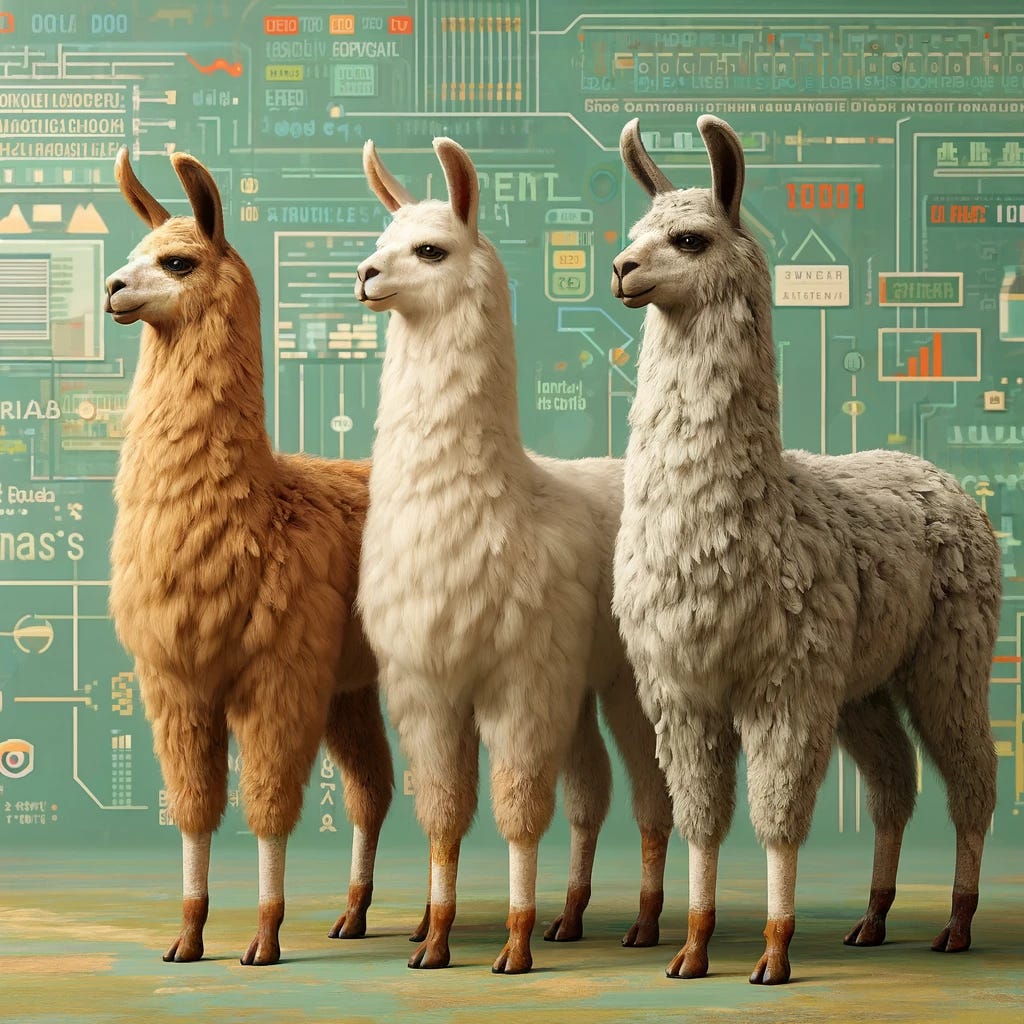

Relation extraction (RE) is the task of extracting relationships from unstructured text to identify connections between various named entities. It is done in conjunction with named entity recognition (NER) and is an essential step in a natural langage processing pipeline. With the rise of Large Language Models (LLMs), traditional supervised approaches that involve tagging entity spans and classifying relationships (if any) between them are enhanced or entirely replaced by LLM-based approaches [1].
Llama3 is the most recent major release in the domain of GenerativeAI [2]. The base model is available in two sizes, 8B and 70B, with a 400B model expected to be released soon. These models are available on the HuggingFace platform; see [3] for details. The 70B variant powers Meta’s new chat website Meta.ai and exhibits performance comparable to ChatGPT. The 8B model is among the most performant in its class. The architecture of Llama3 is similar to that of Llama2, with the increase in performance primarily due to data upgrading. The model comes with an upgaded tokenizer and expanded context window. It is labelled as open-source, although only a small percentage of the data is released. Overall, it is an excellent model, and I cannot wait to give it a try.
Llama3–70B can produce amazing results, but due to its size it is impractical, prohibitively expensive and hard to use on local systems. Therefore, to leverage its capabilities, we have Llama3–70B teach the smaller Llama3–8B the task of relation extraction from unstructured text.
Specifically, with the help of Llama3–70B, we build a supervised fine-tuning dataset aimed at relation extraction. We then use this dataset to fine-tune Llama3–8B to enhance its relation extraction capabilities.
To reproduce the code in the Google Colab Notebook associated to this blog, you will need:
For this project I used a Google Colab Pro equipped with an A100 GPU and a High-RAM setting.
We start by installing all the required libraries:
!pip install -q groq
!pip install -U accelerate bitsandbytes datasets evaluate
!pip install -U peft transformers trl
I was very pleased to notice that the entire setup worked from the beginning without any dependencies issues or the need to install transformers from the source, despite the novelty of the model.
We also need to give access Goggle Colab to the drive and files and set the working directory:
# For Google Colab settings
from google.colab import userdata, drive
# This will prompt for authorization
drive.mount('/content/drive')
# Set the working directory
%cd '/content/drive/MyDrive/postedBlogs/llama3RE'
For those who wish to upload the model to the HuggingFace Hub, we need to upload the Hub credentials. In my case, these are stored in Google Colab secrets, which can be accessed via the key button on the left. This step is optional.
# For Hugging Face Hub setting
from huggingface_hub import login
# Upload the HuggingFace token (should have WRITE access) from Colab secrets
HF = userdata.get('HF')
# This is needed to upload the model to HuggingFace
login(token=HF,add_to_git_credential=True)
I also added some path variables to simplify file access:
# Create a path variable for the data folder
data_path = '/content/drive/MyDrive/postedBlogs/llama3RE/datas/'
# Full fine-tuning dataset
sft_dataset_file = f'{data_path}sft_train_data.json'
# Data collected from the the mini-test
mini_data_path = f'{data_path}mini_data.json'
# Test data containing all three outputs
all_tests_data = f'{data_path}all_tests.json'
# The adjusted training dataset
train_data_path = f'{data_path}sft_train_data.json'
# Create a path variable for the SFT model to be saved locally
sft_model_path = '/content/drive/MyDrive/llama3RE/Llama3_RE/'
Now that our workspace is set up, we can move to the first step, which is to build a synthetic dataset for the task of relation extraction.
There are several relation extraction datasets available, with the best-known being the CoNLL04 dataset. Additionally, there are excellent datasets such as web_nlg, available on HuggingFace, and SciREX developed by AllenAI. However, most of these datasets come with restrictive licenses.
Inspired by the format of the web_nlg dataset we will build our own dataset. This approach will be particularly useful if we plan to fine-tune a model trained on our dataset. To start, we need a collection of short sentences for our relation extraction task. We can compile this corpus in various ways.
We will use databricks-dolly-15k, an open source dataset generated by Databricks employees in 2023. This dataset is designed for supervised fine-tuning and includes four features: instruction, context, response and category. After analyzing the eight categories, I decided to retain the first sentence of the context from the information_extraction category. The data parsing steps are outlined below:
from datasets import load_dataset
# Load the dataset
dataset = load_dataset("databricks/databricks-dolly-15k")
# Choose the desired category from the dataset
ie_category = [e for e in dataset["train"] if e["category"]=="information_extraction"]
# Retain only the context from each instance
ie_context = [e["context"] for e in ie_category]
# Split the text into sentences (at the period) and keep the first sentence
reduced_context = [text.split('.')[0] + '.' for text in ie_context]
# Retain sequences of specified lengths only (use character length)
sampler = [e for e in reduced_context if 30 < len(e) < 170]
The selection process yields a dataset comprising 1,041 sentences. Given that this is a mini-project, I did not handpick the sentences, and as a result, some samples may not be ideally suited for our task. In a project designated for production, I would carefully select only the most appropriate sentences. However, for the purposes of this project, this dataset will suffice.
We first need to create a system message that will define the input prompt and instruct the model on how to generate the answers:
system_message = """You are an experienced annontator.
Extract all entities and the relations between them from the following text.
Write the answer as a triple entity1|relationship|entitity2.
Do not add anything else.
Example Text: Alice is from France.
Answer: Alice|is from|France.
"""
Since this is an experimental phase, I am keeping the demands on the model to a minimum. I did test several other prompts, including some that requested outputs in CoNLL format where entities are categorized, and the model performed quite well. However, for simplicity’s sake, we’ll stick to the basics for now.
We also need to convert the data into a conversational format:
messages = [[
{"role": "system","content": f"{system_message}"},
{"role": "user", "content": e}] for e in sampler]
Llama3 was released just a few days ago, and the availability of API options is still limited. While a chat interface is available for Llama3–70B, this project requires an API that could process my 1,000 sentences with a couple lines of code. I found this excellent YouTube video that explains how to use the GroqCloud API for free. For more details please refer to the video.
Just a reminder: you’ll need to log in and retrieve a free API Key from the GroqCloud website. My API key is already saved in the Google Colab secrets. We start by initializing the Groq client:
import os
from groq import Groq
gclient = Groq(
api_key=userdata.get("GROQ"),
)
Next we need to define a couple of helper functions that will enable us to interact with the Meta.ai chat interface effectively (these are adapted from the YouTube video):
import time
from tqdm import tqdm
def process_data(prompt):
"""Send one request and retrieve model's generation."""
chat_completion = gclient.chat.completions.create(
messages=prompt, # input prompt to send to the model
model="llama3-70b-8192", # according to GroqCloud labeling
temperature=0.5, # controls diversity
max_tokens=128, # max number tokens to generate
top_p=1, # proportion of likelihood weighted options to consider
stop=None, # string that signals to stop generating
stream=False, # if set partial messages are sent
)
return chat_completion.choices[0].message.content
def send_messages(messages):
"""Process messages in batches with a pause between batches."""
batch_size = 10
answers = []
for i in tqdm(range(0, len(messages), batch_size)): # batches of size 10
batch = messages[i:i+10] # get the next batch of messages
for message in batch:
output = process_data(message)
answers.append(output)
if i + 10 < len(messages): # check if there are batches left
time.sleep(10) # wait for 10 seconds
return answers
The first function process_data() serves as a wrapper for the chat completion function of the Groq client. The second function send_messages(), processes the data in small batches. If you follow the Settings link on the Groq playground page, you will find a link to Limits which details the conditions under which we can use the free API, including caps on the number of requests and generated tokens. To avoid exceedind these limits, I added a 10-seconds delay after each batch of 10 messages, although it wasn’t strictly necessary in my case. You might want to experiment with these settings.
What remains now is to generate our relation extraction data and integrate it with the initial dataset :
# Data generation with Llama3-70B
answers = send_messages(messages)
# Combine input data with the generated dataset
combined_dataset = [{'text': user, 'gold_re': output} for user, output in zip(sampler, answers)]
Before proceeding with fine-tuning the model, it’s important to evaluate its performance on several samples to determine if fine-tuning is indeed necessary.
We will select 20 samples from the dataset we just constructed and set them aside for testing. The remainder of the dataset will be used for fine-tuning.
import random
random.seed(17)
# Select 20 random entries
mini_data = random.sample(combined_dataset, 20)
# Build conversational format
parsed_mini_data = [[{'role': 'system', 'content': system_message},
{'role': 'user', 'content': e['text']}] for e in mini_data]
# Create the training set
train_data = [item for item in combined_dataset if item not in mini_data]
We will use the GroqCloud API and the utilities defined above, specifying model=llama3-8b-8192 while the rest of the function remains unchanged. In this case, we can directly process our small dataset without concern of exceeded the API limits.
Here is a sample output that provides the original text, the Llama3-70B generation denoted gold_re and the Llama3-8B hgeneration labelled test_re.
{'text': 'Long before any knowledge of electricity existed, people were aware of shocks from electric fish.',
'gold_re': 'people|were aware of|shocksnshocks|from|electric fishnelectric fish|had|electricity',
'test_re': 'electric fish|were aware of|shocks'}
For the full test dataset, please refer to the Google Colab notebook.
Just from this example, it becomes clear that Llama3–8B could benefit from some improvements in its relation extraction capabilities. Let’s work on enhancing that.
We will utilize a full arsenal of techniques to assist us, including QLoRA and Flash Attention. I won’t delve into the specifics of choosing hyperparameters here, but if you’re interested in exploring further, check out these great references [4] and [5].
The A100 GPU supports Flash Attention and bfloat16, and it possesses about 40GB of memory, which is sufficient for our fine-tuning needs.
We start by parsing the dataset into a conversational format, including a system message, input text and the desired answer, which we derive from the Llama3–70B generation. We then save it as a HuggingFace dataset:
def create_conversation(sample):
return {
"messages": [
{"role": "system","content": system_message},
{"role": "user", "content": sample["text"]},
{"role": "assistant", "content": sample["gold_re"]}
]
}
from datasets import load_dataset, Dataset
train_dataset = Dataset.from_list(train_data)
# Transform to conversational format
train_dataset = train_dataset.map(create_conversation,
remove_columns=train_dataset.features,
batched=False)
model_id = "meta-llama/Meta-Llama-3-8B"
from transformers import AutoTokenizer
# Tokenizer
tokenizer = AutoTokenizer.from_pretrained(model_id,
use_fast=True,
trust_remote_code=True)
tokenizer.pad_token = tokenizer.eos_token
tokenizer.pad_token_id = tokenizer.eos_token_id
tokenizer.padding_side = 'left'
# Set a maximum length
tokenizer.model_max_length = 512
from transformers import BitsAndBytesConfig
bnb_config = BitsAndBytesConfig(
load_in_4bit=True,
bnb_4bit_use_double_quant=True,
bnb_4bit_quant_type="nf4",
bnb_4bit_compute_dtype=torch.bfloat16
)
from transformers import AutoModelForCausalLM
from peft import prepare_model_for_kbit_training
from trl import setup_chat_format
device_map = {"": torch.cuda.current_device()} if torch.cuda.is_available() else None
model = AutoModelForCausalLM.from_pretrained(
model_id,
device_map=device_map,
attn_implementation="flash_attention_2",
quantization_config=bnb_config
)
model, tokenizer = setup_chat_format(model, tokenizer)
model = prepare_model_for_kbit_training(model)
from peft import LoraConfig
# According to Sebastian Raschka findings
peft_config = LoraConfig(
lora_alpha=128, #32
lora_dropout=0.05,
r=256, #16
bias="none",
target_modules=["q_proj", "o_proj", "gate_proj", "up_proj",
"down_proj", "k_proj", "v_proj"],
task_type="CAUSAL_LM",
)
The best results are achieved when targeting all the linear layers. If memory constraints are a concern, opting for more standard values such as alpha=32 and rank=16 can be beneficial, as these settings result in significantly fewer parameters.
from transformers import TrainingArguments
# Adapted from Phil Schmid blogpost
args = TrainingArguments(
output_dir=sft_model_path, # directory to save the model and repository id
num_train_epochs=2, # number of training epochs
per_device_train_batch_size=4, # batch size per device during training
gradient_accumulation_steps=2, # number of steps before performing a backward/update pass
gradient_checkpointing=True, # use gradient checkpointing to save memory, use in distributed training
optim="adamw_8bit", # choose paged_adamw_8bit if not enough memory
logging_steps=10, # log every 10 steps
save_strategy="epoch", # save checkpoint every epoch
learning_rate=2e-4, # learning rate, based on QLoRA paper
bf16=True, # use bfloat16 precision
tf32=True, # use tf32 precision
max_grad_norm=0.3, # max gradient norm based on QLoRA paper
warmup_ratio=0.03, # warmup ratio based on QLoRA paper
lr_scheduler_type="constant", # use constant learning rate scheduler
push_to_hub=True, # push model to Hugging Face hub
hub_model_id="llama3-8b-sft-qlora-re",
report_to="tensorboard", # report metrics to tensorboard
)
If you choose to save the model locally, you can omit the last three parameters. You may also need to adjust the per_device_batch_size and gradient_accumulation_steps to prevent Out of Memory (OOM) errors.
from trl import SFTTrainer
trainer = SFTTrainer(
model=model,
args=args,
train_dataset=sft_dataset,
peft_config=peft_config,
max_seq_length=512,
tokenizer=tokenizer,
packing=False, # True if the dataset is large
dataset_kwargs={
"add_special_tokens": False, # the template adds the special tokens
"append_concat_token": False, # no need to add additional separator token
}
)
trainer.train()
trainer.save_model()
The training, including model saving, took about 10 minutes.
Let’s clear the memory to prepare for inference tests. If you’re using a GPU with less memory and encounter CUDA Out of Memory (OOM) errors, you might need to restart the runtime.
import torch
import gc
del model
del tokenizer
gc.collect()
torch.cuda.empty_cache()
In this final step we will load the base model in half precision along with the Peft adapter. For this test, I have chosen not to merge the model with the adapter.
from peft import AutoPeftModelForCausalLM
from transformers import AutoTokenizer, pipeline
import torch
# HF model
peft_model_id = "solanaO/llama3-8b-sft-qlora-re"
# Load Model with PEFT adapter
model = AutoPeftModelForCausalLM.from_pretrained(
peft_model_id,
device_map="auto",
torch_dtype=torch.float16,
offload_buffers=True
)
Next, we load the tokenizer:
okenizer = AutoTokenizer.from_pretrained(peft_model_id)
tokenizer.pad_token = tokenizer.eos_token
tokenizer.pad_token_id = tokenizer.eos_token_id
And we build the text generation pipeline:
pipe = pipeline("text-generation", model=model, tokenizer=tokenizer)
We load the test dataset, which consists of the 20 samples we set aside previously, and format the data in a conversational style. However, this time we omit the assistant message and format it as a Hugging Face dataset:
def create_input_prompt(sample):
return {
"messages": [
{"role": "system","content": system_message},
{"role": "user", "content": sample["text"]},
]
}
from datasets import Dataset
test_dataset = Dataset.from_list(mini_data)
# Transform to conversational format
test_dataset = test_dataset.map(create_input_prompt,
remove_columns=test_dataset.features,
batched=False)
Let’s generate relation extraction output using SFT Llama3–8B and compare it to the previous two outputs on a single instance:
Generate the input prompt
prompt = pipe.tokenizer.apply_chat_template(test_dataset[2]["messages"][:2],
tokenize=False,
add_generation_prompt=True)
# Generate the output
outputs = pipe(prompt,
max_new_tokens=128,
do_sample=False,
temperature=0.1,
top_k=50,
top_p=0.1,
)
# Display the results
print(f"Question: {test_dataset[2]['messages'][1]['content']}n")
print(f"Gold-RE: {test_sampler[2]['gold_re']}n")
print(f"LLama3-8B-RE: {test_sampler[2]['test_re']}n")
print(f"SFT-Llama3-8B-RE: {outputs[0]['generated_text'][len(prompt):].strip()}")
We obtain the following:
Question: Long before any knowledge of electricity existed, people were aware of shocks from electric fish.
Gold-RE: people|were aware of|shocks
shocks|from|electric fish
electric fish|had|electricity
LLama3-8B-RE: electric fish|were aware of|shocks
SFT-Llama3-8B-RE: people|were aware of|shocks
shocks|from|electric fish
In this example, we observe significant improvements in the relation extraction capabilities of Llama3–8B through fine-tuning. Despite the fine-tuning dataset being neither very clean nor particularly large, the results are impressive.
For the complete results on the 20-sample dataset, please refer to the Google Colab notebook. Note that the inference test takes longer because we load the model in half-precision.
In conclusion, by utilizing Llama3–70B and an available dataset, we successfully created a synthetic dataset which was then used to fine-tune Llama3–8B for a specific task. This process not only familiarized us with Llama3, but also allowed us to apply straightforward techniques from Hugging Face. We observed that working with Llama3 closely resembles the experience with Llama2, with the notable improvements being enhanced output quality and a more effective tokenizer.
For those interested in pushing the boundaries further, consider challenging the model with more complex tasks such as categorizing entities and relationships, and using these classifications to build a knowledge graph.
databricks-dolly-15K on Hugging Face platform (CC BY-SA 3.0)
Relation Extraction with Llama3 Models was originally published in Towards Data Science on Medium, where people are continuing the conversation by highlighting and responding to this story.
Originally appeared here:
Relation Extraction with Llama3 Models
Go Here to Read this Fast! Relation Extraction with Llama3 Models


This article discusses Llama3, the newest language model made available from Meta, and how you can run the model locally
Originally appeared here:
Unleash Llama3 — How you can use the latest big-tech open-source LLM
Go Here to Read this Fast! Unleash Llama3 — How you can use the latest big-tech open-source LLM

Welcome to my series on Causal AI, where we will explore the integration of causal reasoning into machine learning models. Expect to explore a number of practical applications across different business contexts.
In the last article we explored de-biasing treatment effects with Double Machine Learning. This time we will delve further into the potential of DML covering using Double Machine Learning and Linear Programming to optimise treatment strategies.
If you missed the last article on Double Machine Learning, check it out here:
De-biasing Treatment Effects with Double Machine Learning
This article will showcase how Double Machine Learning and Linear Programming can be used optimise treatment strategies:
Expect to gain a broad understanding of:
The full notebook can be found here:
There is a common question which arises in most businesses: “What is the optimal treatment for a customer in order to maximise future sales whilst minimising cost?”.
Let’s break this idea down with a simple example.
Your business sells socks online. You don’t sell an essential product, so you need to encourage existing customers to repeat purchase. Your main lever for this is sending out discounts. So the treatment strategy in this case is sending out discounts:
Each discount has a different return on investment. If you think back to the last article on average treatment effects, you can probably see how we can calculate ATE for each of these discounts and then select the one with the highest return.
However, what if we have heterogenous treatment effects — The treatment effect varies across different subgroups of the population.
This is when we need to start considering conditional average treatment effects (CATE)!
CATE is the average impact of a treatment or intervention on different subgroups of a population. ATE was very much about “does this treatment work?” whereas CATE allows us to change the question to “who should we treat?”.
We “condition” on our control features to allow treatment effects to vary depending on customer characteristics.
Think back to the example where we are sending out discounts. If customers with a higher number of previous orders respond better to discounts, we can condition on this customer characteristic.
It is worth pointing out that in Marketing, estimating CATE is often referred to as Uplift Modelling.
We covered DML in the last article, but just in case you need a bit of a refresher:
“First stage:
Second stage:
We can use Double Machine Learning to estimate CATE by interacting our control features (X) with the treatment effect in the second stage model.
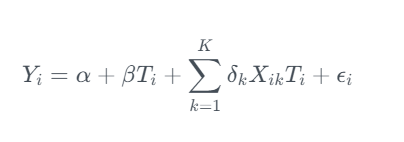
This can be really powerful as we are now able to get customer level treatment effects!
Linear programming is an optimisation method which can be used to find the optimal solution of a linear function given some constraints. It is often used to solve transportation, scheduling and resource allocation problems. A more generic term which you might see used is Operations Research.
Let’s break linear programming down with a simple example:
The intersection of all constraints forms a feasible region, which is the set of all possible solutions that satisfy the given constraints. The goal of linear programming is to find the point within the feasible region that optimizes the objective function.
Assignment problems are a specific type of linear programming problem where the goal is to assign a set of “tasks” to a set of “agents”. Lets use an example to bring it to life:
You run an experiment where you send different discounts out to 4 random groups of existing customers (the 4th of which actually you don’t send any discount). You build 2 CATE models — (1) Estimating how the offer value effects the order value and (2) Estimating how offer value effects the cost.
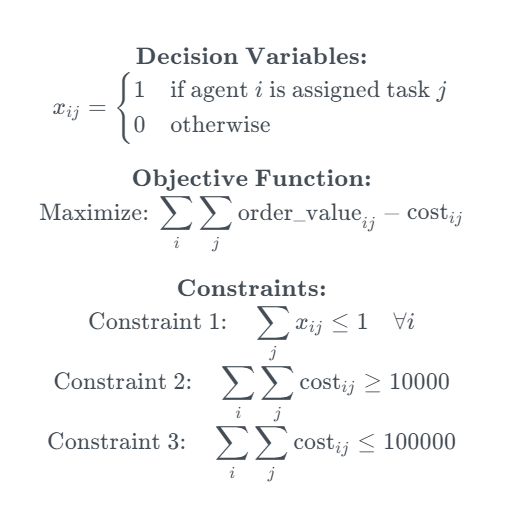
We basically want to find out the optimal treatment for each customer given some overall cost constraints. And linear programming can help us do this!
It is worth noting that this problem is “NP hard”, a classification of problems that are at least as hard as the hardest problems in NP (nondeterministic polynomial time).
Linear programming is a really tricky but rewarding topic. I’ve tried to introduce the idea to get us started — If you want to learn more I recommend this resource:
Hands-On Linear Programming: Optimization With Python – Real Python
OR tools is an open source package developed by Google which can solve a range of linear programming problems, including assignment problems. We will demonstrate it in action later in the article.
OR-Tools | Google for Developers
We are going to continue with the assignment problem example and illustrate how we can solve this in Python.
We set up a data generating process with the following characteristics:
The X features are customer characteristics taken before the treatment:

T is a binary flag indicating whether the customer received the offer. We create three different treatment interactions to allow us to simulate different treatment effects.

def data_generator(tau_weight, interaction_num):
# Set number of observations
n=10000
# Set number of features
p=10
# Create features
X = np.random.uniform(size=n * p).reshape((n, -1))
# Nuisance parameters
b = (
np.sin(np.pi * X[:, 0] * X[:, 1])
+ 2 * (X[:, 2] - 0.5) ** 2
+ X[:, 3]
+ 0.5 * X[:, 4]
+ X[:, 5] * X[:, 6]
+ X[:, 7] ** 3
+ np.sin(np.pi * X[:, 8] * X[:, 9])
)
# Create binary treatment
T = np.random.binomial(1, expit(b))
# treatment interactions
interaction_1 = X[:, 0] * X[:, 1] + X[:, 2]
interaction_2 = X[:, 3] * X[:, 4] + X[:, 5]
interaction_3 = X[:, 6] * X[:, 7] + X[:, 9]
# Set treatment effect
if interaction_num==1:
tau = tau_weight * interaction_1
elif interaction_num==2:
tau = tau_weight * interaction_2
elif interaction_num==3:
tau = tau_weight * interaction_3
# Calculate outcome
y = b + T * tau + np.random.normal(size=n)
return X, T, tau, y
We can use the data generator to simulate three treatments, each with a different treatment effect.
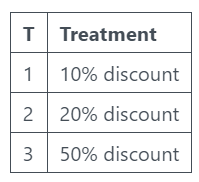
np.random.seed(123)
# Generate samples for 3 different treatments
X1, T1, tau1, y1 = data_generator(0.75, 1)
X2, T2, tau2, y2 = data_generator(0.50, 2)
X3, T3, tau3, y3 = data_generator(0.90, 3)
As in the last article, the data generating process python code is based on the synthetic data creator from Ubers Causal ML package:
causalml/causalml/dataset/regression.py at master · uber/causalml
We then train three DML models using LightGBM as flexible first stage models. This should allow us to capture the difficult nuisance parameters whilst correctly calculating the treatment effect.
Pay attention to how we pass the X features in through X rather than W (unlike in the last article where we passed the X features through W). Features passed through X will be used in both the first and second stage models — In the second stage model the features are used to create interaction terms with the treatment residual.
np.random.seed(123)
# Train DML model using flexible stage 1 models
dml1 = LinearDML(model_y=LGBMRegressor(), model_t=LGBMClassifier(), discrete_treatment=True)
dml1.fit(y1, T=T1, X=X1, W=None)
# Train DML model using flexible stage 1 models
dml2 = LinearDML(model_y=LGBMRegressor(), model_t=LGBMClassifier(), discrete_treatment=True)
dml2.fit(y2, T=T2, X=X2, W=None)
# Train DML model using flexible stage 1 models
dml3 = LinearDML(model_y=LGBMRegressor(), model_t=LGBMClassifier(), discrete_treatment=True)
dml3.fit(y3, T=T3, X=X3, W=None)
When we plot the actual vs estimated CATE, we see that the model does a reasonable job.
# Create a figure and subplots
fig, axes = plt.subplots(1, 3, figsize=(15, 5))
# Plot scatter plots on each subplot
sns.scatterplot(x=dml1.effect(X1), y=tau1, ax=axes[0])
axes[0].set_title('Treatment 1')
axes[0].set_xlabel('Estimated CATE')
axes[0].set_ylabel('Actual CATE')
sns.scatterplot(x=dml2.effect(X2), y=tau2, ax=axes[1])
axes[1].set_title('Treatment 2')
axes[1].set_xlabel('Estimated CATE')
axes[1].set_ylabel('Actual CATE')
sns.scatterplot(x=dml3.effect(X3), y=tau3, ax=axes[2])
axes[2].set_title('Treatment 3')
axes[2].set_xlabel('Estimated CATE')
axes[2].set_ylabel('Actual CATE')
# Add labels to the entire figure
fig.suptitle('Actual vs Estimated')
# Show plots
plt.show()

We will start by exploring this as an optimisation problem. We have a three treatments which a customer could receive. Below we create a mapping for the cost of each treatment, and set an overall cost constraint.
# Create mapping for cost of each treatment
cost_dict = {'T1': 0.1, 'T2': 0.2, 'T3': 0.3}
# Set constraints
max_cost = 3000
We can then estimate the CATE for each customer and then initially select each customers best treatment. However, selecting the best treatment doesn’t keep us within the maximum cost constraint. Therefore select the customers with the highest CATE until we reach our max cost constraint.
# Concatenate features
X = np.concatenate((X1, X2, X3), axis=0)
# Estimate CATE for each treatment using DML models
Treatment_1 = dml1.effect(X)
Treatment_2 = dml2.effect(X)
Treatment_3 = dml3.effect(X)
cate = pd.DataFrame({"T1": Treatment_1, "T2": Treatment_2, "T3": Treatment_3})
# Select the best treatment for each customer
best_treatment = cate.idxmax(axis=1)
best_value = cate.max(axis=1)
# Map cost for each treatment
best_cost = pd.Series([cost_dict[value] for value in best_treatment])
# Create dataframe with each customers best treatment and associated cost
best_df = pd.concat([best_value, best_cost], axis=1)
best_df.columns = ["value", "cost"]
best_df = best_df.sort_values(by=['value'], ascending=False).reset_index(drop=True)
# Naive optimisation
best_df_cum = best_df.cumsum()
opt_index = best_df_cum['cost'].searchsorted(max_cost)
naive_order_value = round(best_df_cum.iloc[opt_index]['value'], 0)
naive_cost_check = round(best_df_cum.iloc[opt_index]['cost'], 0)
print(f'The total order value from the naive treatment strategy is {naive_order_value} with a cost of {naive_cost_check}')

We start by creating a dataframe with the cost of each treatment for each customer.
# Cost mapping for all treatments
cost_mapping = {'T1': [cost_dict["T1"]] * 30000,
'T2': [cost_dict["T2"]] * 30000,
'T3': [cost_dict["T3"]] * 30000}
# Create DataFrame
df_costs = pd.DataFrame(cost_mapping)
Now it’s time to use the OR Tools package to solve this assignment problem! The code takes the following inputs:
The code outputs a dataframe with each customers potential treatment, and a column indicating which one is the optimal assignment.
solver = pywraplp.Solver.CreateSolver('SCIP')
# Set constraints
max_cost = 3000
min_cost = 3000
# Create input arrays
costs = df_costs.to_numpy()
order_value = cate.to_numpy()
num_custs = len(costs)
num_treatments = len(costs[0])
# x[i, j] is an array of 0-1 variables, which will be 1 if customer i is assigned to treatment j.
x = {}
for i in range(num_custs):
for j in range(num_treatments):
x[i, j] = solver.IntVar(0, 1, '')
# Each customer is assigned to at most 1 treatment.
for i in range(num_custs):
solver.Add(solver.Sum([x[i, j] for j in range(num_treatments)]) <= 1)
# Cost constraints
solver.Add(sum([costs[i][j] * x[i, j] for j in range(num_treatments) for i in range(num_custs)]) <= max_cost)
solver.Add(sum([costs[i][j] * x[i, j] for j in range(num_treatments) for i in range(num_custs)]) >= min_cost)
# Objective
objective_terms = []
for i in range(num_custs):
for j in range(num_treatments):
objective_terms.append((order_value[i][j] * x[i, j] - costs[i][j] * x[i, j] ))
solver.Maximize(solver.Sum(objective_terms))
# Solve
status = solver.Solve()
assignments = []
values = []
if status == pywraplp.Solver.OPTIMAL or status == pywraplp.Solver.FEASIBLE:
for i in range(num_custs):
for j in range(num_treatments):
# Test if x[i,j] is 1 (with tolerance for floating point arithmetic).
if x[i, j].solution_value() > -0.5:
assignments.append([i, j])
values.append([x[i, j].solution_value(), costs[i][j] * x[i, j].solution_value(), order_value[i][j]])
# Create a DataFrame from the collected data
df = pd.DataFrame(assignments, columns=['customer', 'treatment'])
df['assigned'] = [x[0] for x in values]
df['cost'] = [x[1] for x in values]
df['order_value'] = [x[2] for x in values]
df
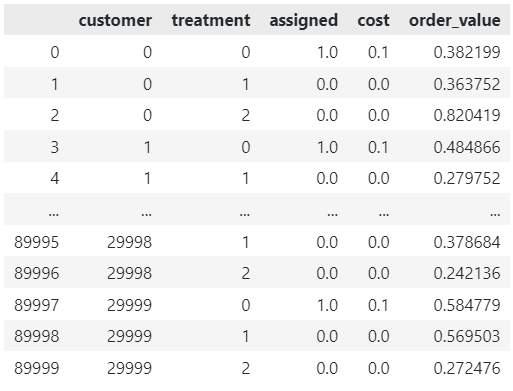
Whilst keeping to the cost constraint of £3k, we can generate £18k in order value using the optimised treatment strategy. This is 36% higher than the naive approach!
opt_order_value = round(df['order_value'][df['assigned'] == 1].sum(), 0)
opt_cost_check = round(df['cost'][df['assigned'] == 1].sum(), 0)
print(f'The total order value from the optimised treatment strategy is {opt_order_value} with a cost of {opt_cost_check}')

Today we covered using Double Machine Learning and Linear Programming to optimise treatment strategies. Here are some closing thoughts:
EconML/notebooks/Double Machine Learning Examples.ipynb at main · py-why/EconML
Follow me if you want to continue this journey into Causal AI — In the next article we will explore how we can estimate non-linear treatment effects in pricing and marketing optimisation problems.
Using Double Machine Learning and Linear Programming to optimise treatment strategies was originally published in Towards Data Science on Medium, where people are continuing the conversation by highlighting and responding to this story.
Originally appeared here:
Using Double Machine Learning and Linear Programming to optimise treatment strategies
Learn how to build an efficient pipeline with Hydra and MLflow
Originally appeared here:
Hyperparameters Tuning with MLflow and Hydra Sweeps
Go Here to Read this Fast! Hyperparameters Tuning with MLflow and Hydra Sweeps
Process huge volumes of data with Python and DuckDB — An AWS S3 example.
Originally appeared here:
DuckDB and AWS — How to Aggregate 100 Million Rows in 1 Minute
Go Here to Read this Fast! DuckDB and AWS — How to Aggregate 100 Million Rows in 1 Minute